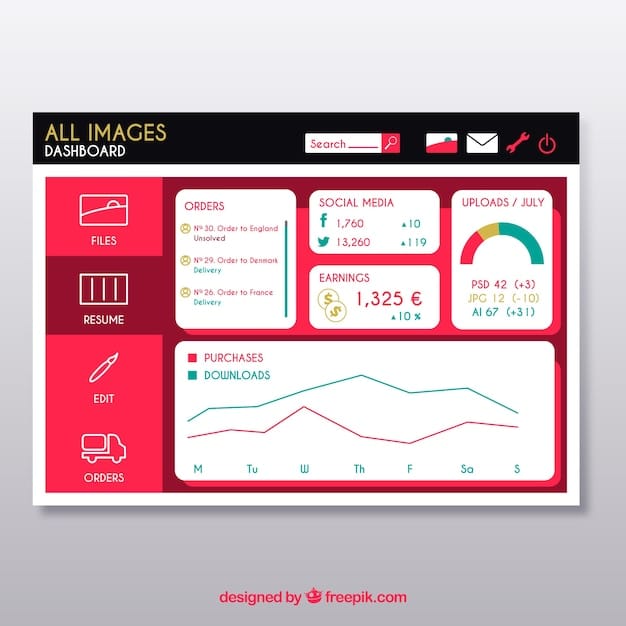E-commerce A/B Testing: Data-Driven Digital Marketing

E-commerce A/B testing is a powerful method to refine your digital marketing strategies by systematically experimenting with different variations of web pages, ads, or emails, leveraging data to optimize user experience and boost conversion rates.
Are you looking to enhance your e-commerce digital marketing strategy? **E-commerce A/B testing: Improving Your Digital Marketing with Data** could be the solution to turning your website into a conversion machine. By using data-driven insights, you can optimize user experience and improve your bottom line.
Understanding E-commerce A/B Testing
E-commerce A/B testing is not just about making guesses; it’s about using a scientific approach to improve your online store’s performance. Let’s dive deeper into what it is and why it’s important.
What is A/B Testing?
A/B testing, also known as split testing, involves comparing two versions of a webpage or app element to see which one performs better. This is done by splitting your audience into two groups: one group sees the original version (A), and the other group sees the modified version (B).
By monitoring the behavior of visitors on each version, you can determine which one leads to better results, such as higher conversion rates or increased sales.
Why is A/B Testing Important for E-commerce?
In e-commerce, even small changes can lead to significant improvements in sales and customer satisfaction. A/B testing helps you make informed decisions based on data, rather than relying on assumptions.
- Increases Conversion Rates: Identify and implement changes that encourage more visitors to make a purchase.
- Improves User Experience: Optimize your website for ease of navigation and customer satisfaction.
- Reduces Bounce Rates: Discover what keeps visitors engaged on your site.
- Maximizes ROI: Get the most out of your marketing efforts by using strategies that are proven to work.
In conclusion, understanding the basics of e-commerce A/B testing is crucial for optimizing your online store. By using a data-driven approach, you can make informed decisions that lead to better results.

Setting Up Your First A/B Test
Now that you know what A/B testing is and why it’s important, let’s look at how to set up your first test. Here are the key steps to follow to ensure a successful experiment.
Define Your Goals
Before you start testing, define what you want to achieve. Are you aiming to increase sales, reduce bounce rates, or improve user engagement? Having clear goals will help you focus your efforts and measure your success.
For example, if your goal is to increase sales, you might focus on testing changes to your product pages, such as optimizing your call-to-action buttons or improving your product descriptions.
Choose What to Test
Identify the areas of your website that you want to improve. This could be anything from headlines and images to button colors and page layouts. Prioritize the elements that are likely to have the biggest impact.
- Headlines and Taglines: Test different messaging to see which one resonates best with your audience.
- Call-to-Action Buttons: Experiment with different colors, sizes, and wording to encourage more clicks.
- Images and Videos: Try different visuals to see which ones capture visitors’ attention.
- Page Layouts: Optimize the arrangement of elements on your page to improve user experience.
In summary, setting up your first A/B test involves defining clear goals and choosing the right elements to test. By following these steps, you can ensure that your experiment is focused and effective.
Key Elements to A/B Test in E-commerce
What elements should you focus on when conducting A/B tests for your e-commerce site? Here are some key areas that can significantly impact your conversion rates and user experience.
Product Page Optimizations
Your product pages are crucial for converting visitors into customers. Optimizing these pages can lead to a significant boost in sales and customer satisfaction.
Start by testing different product descriptions, images, and pricing strategies. Use high-quality images and videos to showcase your products, and make sure your product descriptions are clear, concise, and persuasive.
Checkout Process Improvements
The checkout process is often the point where many potential customers abandon their carts. Making improvements to this process can reduce cart abandonment rates and increase sales.
- Simplify the Checkout Process: Reduce the number of steps required to complete a purchase.
- Offer Multiple Payment Options: Provide customers with a variety of payment methods to choose from.
- Improve Trust Signals: Use security badges and guarantees to reassure customers about the safety of their transactions.
Homepage Design
Your homepage is the first impression many visitors will have of your brand. It’s important to make it engaging and easy to navigate. Experiment with different layouts, headlines, and call-to-action buttons.
In essence, the key elements to A/B test in e-commerce cover a wide range of areas, from product pages to the checkout process. By focusing on these elements, you can make targeted improvements that drive better results.

Analyzing A/B Testing Results
Running A/B tests is only half the battle. Analyzing the results is crucial for understanding what works and what doesn’t. Here’s how to interpret your data and make informed decisions.
Understanding Key Metrics
To accurately measure the success of your A/B tests, you need to track the right metrics. Here are some key metrics to consider:
Conversion Rate: The percentage of visitors who complete a desired action, such as making a purchase or filling out a form.
Bounce Rate: The percentage of visitors who leave your website after viewing only one page.
Tools for A/B Testing Analysis
There are many tools available that can help you analyze your A/B testing results. These tools provide valuable insights into user behavior and help you make data-driven decisions.
- Google Optimize: A free tool that allows you to run A/B tests and analyze your results directly within Google Analytics.
- Optimizely: A comprehensive platform with advanced features for running and analyzing A/B tests.
- VWO (Visual Website Optimizer): A user-friendly tool that makes it easy to create and analyze A/B tests.
In conclusion, analyzing A/B testing results is essential for understanding what drives success on your e-commerce site. By focusing on key metrics and utilizing the right tools, you can make informed decisions that lead to better results.
Avoiding Common A/B Testing Mistakes
While A/B testing can be a powerful tool, there are several common mistakes that can lead to inaccurate results and wasted efforts. Here’s how to avoid these pitfalls.
Testing Too Many Elements at Once
Testing multiple elements simultaneously can make it difficult to determine which changes are driving the results. It’s best to focus on testing one element at a time to isolate the impact of each change.
For example, if you’re testing both a new headline and a new call-to-action button, you won’t be able to tell which one is responsible for any increase in conversion rates.
Ignoring Statistical Significance
Statistical significance is a measure of whether your results are likely to be genuine or due to chance. Ignoring statistical significance can lead you to make decisions based on inaccurate data.
- Use a Statistical Significance Calculator: There are many online tools that can help you determine whether your results are statistically significant.
- Ensure Adequate Sample Size: Make sure you have enough visitors in each test group to produce reliable results.
Not Testing Long Enough
Running your A/B tests for an insufficient amount of time can lead to inaccurate conclusions. Short-term results may not reflect long-term trends.
In summary, avoiding common A/B testing mistakes is crucial for obtaining accurate and reliable results. By focusing on testing one element at a time, ensuring statistical significance, and running your tests for an adequate amount of time, you can make data-driven decisions that lead to better outcomes.
Advanced A/B Testing Strategies
Once you’ve mastered the basics of A/B testing, you can explore more advanced strategies to further optimize your e-commerce site. Here are some techniques to take your testing to the next level.
Personalization
Personalization involves tailoring the content and offers on your website to individual users based on their behavior, preferences, and demographics. A/B testing can help you determine the most effective personalization strategies.
For example, you can test different product recommendations based on a user’s browsing history or tailor your messaging based on their location.
Multivariate Testing
Multivariate testing involves testing multiple variations of multiple elements simultaneously. This can be more efficient than A/B testing when you want to explore a wide range of possible combinations.
- Complex Approach: Multivariate testing requires more advanced tools and statistical analysis techniques.
- In-Depth Insights: You can identify the most effective combinations of elements on your website.
In conclusion, advanced A/B testing strategies such as personalization and multivariate testing can help you further optimize your e-commerce site and deliver more personalized experiences to your users. By leveraging these techniques, you can drive even better results and stay ahead of the competition.
| Key Point | Brief Description |
|---|---|
| 💡 Define Goals | Establish clear objectives before starting your A/B tests. |
| 🎯 Choose Elements | Select specific elements like headlines or buttons for testing. |
| 📈 Analyze Results | Use key metrics to interpret and make informed decisions. |
| 🚫 Avoid Mistakes | Prevent errors like testing too many elements simultaneously. |
FAQ
▼
Statistical significance indicates whether the results of your A/B test are likely real or due to chance, aiding in making informed decisions based on reliable data.
▼
Run your A/B test long enough to gather sufficient data, usually a week or two, to account for variations in user behavior and traffic patterns.
▼
While possible, testing multiple elements simultaneously (multivariate testing) complicates identifying which specific change caused the observed outcome.
▼
Track key metrics like conversion rates, bounce rates, click-through rates, and revenue per visitor to evaluate the performance of your A/B tests.
▼
Employ tools like Google Optimize, Optimizely, or VWO for setting up, running, and analyzing your A/B tests effectively, ensuring data-driven decisions.
Conclusion
In conclusion, **e-commerce A/B testing** is an indispensable tool for digital marketers looking to optimize their online stores. By understanding the fundamentals, setting up tests correctly, analyzing results effectively, and avoiding common mistakes, you can unlock significant improvements in user experience and conversion rates, ultimately driving more revenue for your business. Embrace the power of data, and let A/B testing guide you towards e-commerce success.





